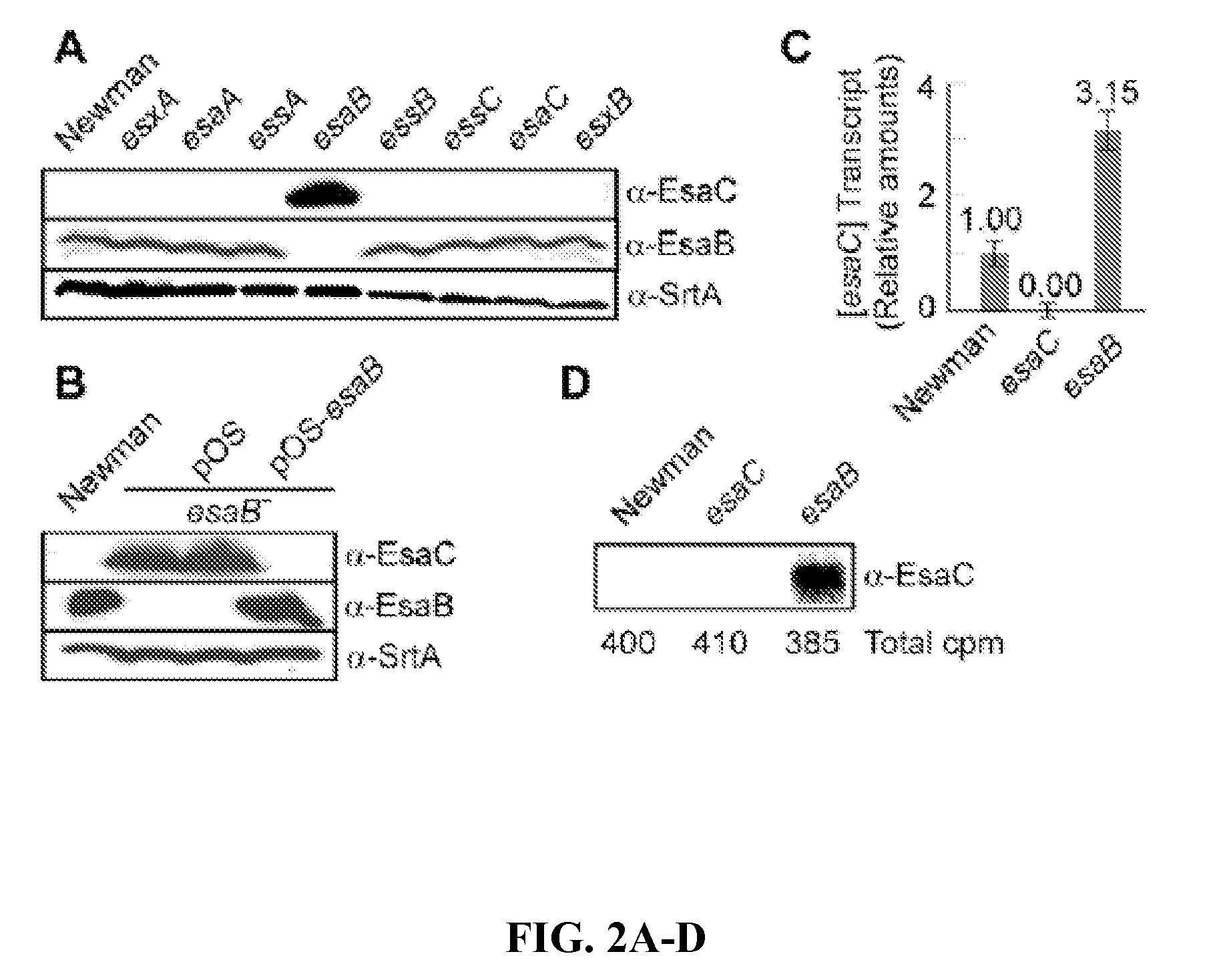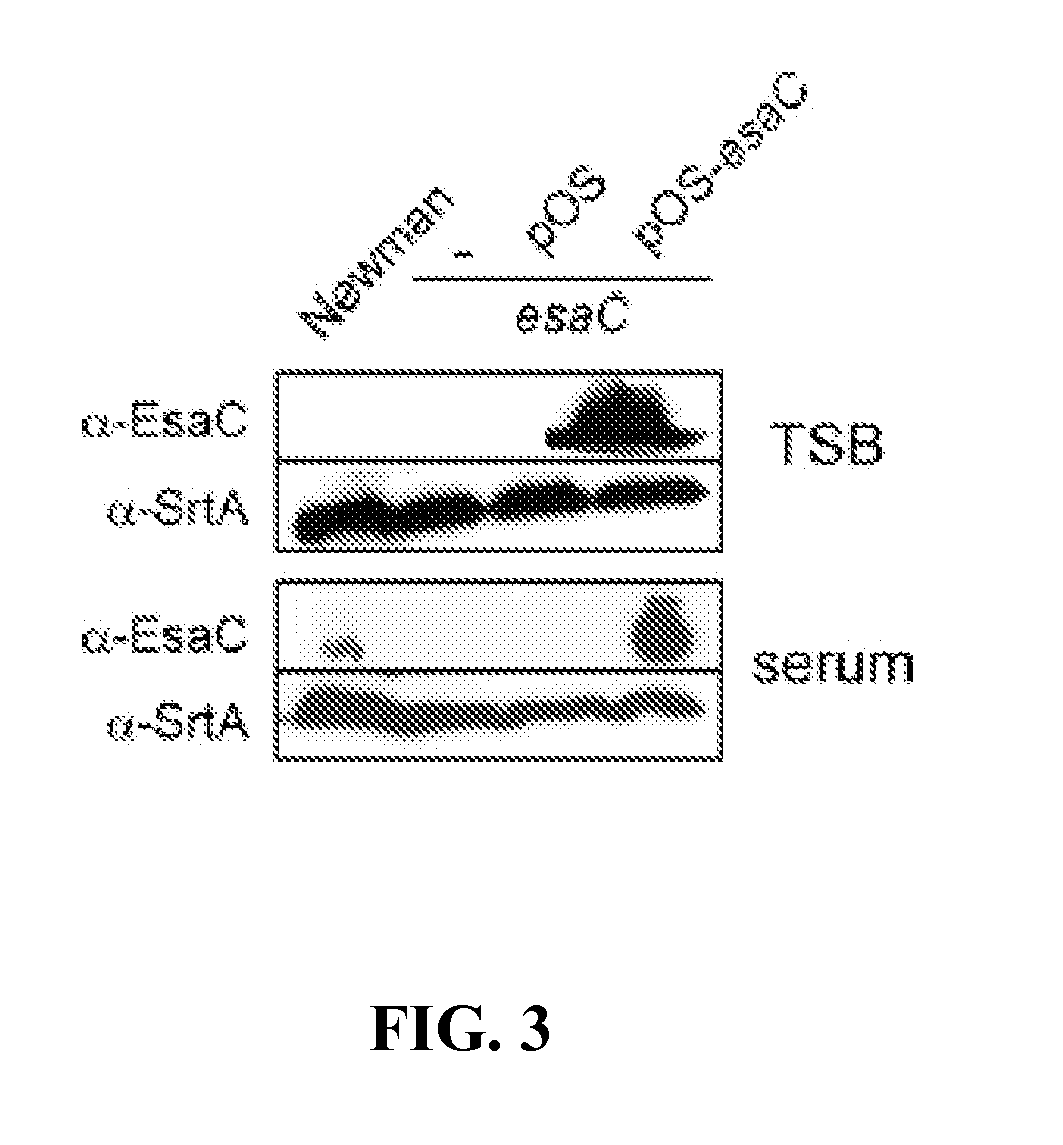Compositions and methods related to Staphylococcal bacterium proteins
a staphylococcal bacterium and protein technology, applied in the field of immunology, microbiology and pathology, can solve the problem of inability to promote persistent abscesses during animal infection, and achieve the effects of accurately determining the useful dose in humans, preventing, alleviating or ameliorating symptoms of disease or infection, and prolonging the survival of subjects
- Summary
- Abstract
- Description
- Claims
- Application Information
AI Technical Summary
Benefits of technology
Problems solved by technology
Method used
Image
Examples
example 1
EsaC and its Role in Staphylococcus Infection
[0335]Sequence analysis of EsaB and EsaC. esaB encodes an 80 amino acid protein that is conserved in the genome of many Gram-positive bacteria. Further, esaB-like genes are always found closely associated on the chromosome of Gram-positive bacteria with esxA- and essC-like genes (FIG. 1). The crystal structure of B. subtilis YukD (EsaB homologue) was recently solved and shown to adopt a fold that is closely related to ubiquitin. YukD lacks the C-terminal peptide that is crucial for the activity of ubiquitin, suggesting that YukD is unlikely to modify other polypeptides by covalent linkage (van den Ent and Lowe, 2005). EsaB is a predicted soluble protein without a canonical signal peptide. esaC encodes a predicted soluble 130 amino acid protein that is conserved in the genomes of staphylococci, but absent from the genomes of other bacteria. In all staphylococcal genomes sequenced thus far, esaC is located between essC and esxB on the staph...
example 2
Experimental Procedures
[0345]Bacterial strains, plasmids and growth conditions. S. aureus cells were grown in tryptic soy broth at 37° C., respectively. Chloramphenicol and erythromycin were used at 10 mg / L, for plasmid and allele selection, respectively, when necessary. S. aureus strains MW2, Mu50, N315, USA100, USA200, USA300, and USA700, were obtained through the Network on Antimicrobial Resistance in S. aureus (NARSA, NIAID). All mutants used in this study with the exception of esaC were obtained from the Phoenix (ΦNΞ) library (Bae et al., 2004). Each Phoenix isolate is a derivative of the clinical isolate Newman (Bae et al., 2004; Duthie and Lorenz, 1952). All bursa aurealis insertions were transduced into wild-type S. aureus Newman or USA300 using bacteriophage φ85 and verified by PCR analysis using flanking primers. For deletion of esaC, a 2-kbp DNA fragment flanking the esaC gene but carrying only the first and last four codons of esaC gene was amplified by PCR, with abutted...
PUM
| Property | Measurement | Unit |
|---|---|---|
| temperatures | aaaaa | aaaaa |
| temperatures | aaaaa | aaaaa |
| temperatures | aaaaa | aaaaa |
Abstract
Description
Claims
Application Information
 Login to View More
Login to View More - R&D
- Intellectual Property
- Life Sciences
- Materials
- Tech Scout
- Unparalleled Data Quality
- Higher Quality Content
- 60% Fewer Hallucinations
Browse by: Latest US Patents, China's latest patents, Technical Efficacy Thesaurus, Application Domain, Technology Topic, Popular Technical Reports.
© 2025 PatSnap. All rights reserved.Legal|Privacy policy|Modern Slavery Act Transparency Statement|Sitemap|About US| Contact US: help@patsnap.com



